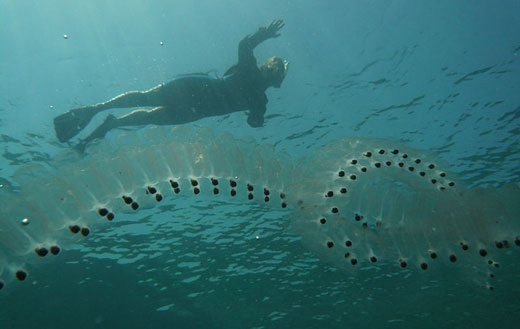Chambered Nautilus
Chambered Nautilus also known as the Emperor Nautilus is one of the oldest species of cephalopods on Earth. This highly developed sea snail has survived for more than 550 million years. The word “Nautilus” means “sailor” in Greek and these creatures are found in the eastern part of the Indian Ocean.
Nautiluses lead a different lifestyle than other cephalopods such as octopuses – they spend their lives hidden in a strong shell. The shell’s diameter is about 20-25 cm, and is curled in a perfect spiral and there are multiple separate chambers within. The colouration varies from reddish brown mixed with creamy to bright red, and if looking closely, you can see age rings on the shell, much like the annual rings which can be observed on a tree crosscut.
Chambered Nautilus lives in coastal waters, in the depths of 60-650 meters. Nautiluses have a very poor vision and they orientate mostly by smell, allowing them to hunt in very dark parts of the ocean. Many zoologists believe that Nautiluses often migrate, because they have been observed near the shores of South Africa, Madagascar and New Zealand, although it’s a fact that dead Nautilus’ shell can float near the surface of the water for a few weeks, thus the hypothesis still remains to be proven.
Despite their rather modest appearance, Chambered Nautiluses are actually capable sea predators. They feed on fish, shrimps, lobsters, crabs and sometimes carrion. Interestingly, they don’t actually have a specific hunting strategy – they just bite large chunks out of the victim’s body with their strong beak-like jaws. Surely, this method isn’t very useful against anything that is faster than the Nautilus, but many small sea animals become prey to this animal, being caught off-guard, not expecting an attack from the relatively small shell-covered creature.

Despite being quite large, the Nautilus' eyes are poorly developed and are not much of a help when looking for food
Even nowadays, it’s unknown when these small sea creatures mate. It is known that after copulation, the female lays about 10 eggs, which take no longer than a few months to hatch, while the youngest specimen observed to copulate in captivity was 6 months old. With the life expectancy of these creatures being unknown, it’s hard to estimate the current population numbers.
Remarkable is the fact that Chambered Nautiluses have incredible regenerative capabilities. Wounds heal in a matter of few hours, leaving no scars, and if a tentacle is lost, a new one is grown rather quickly. This, however, hasn’t helped the animal recover from great population loss due to massive fishing. Even though Nautilus’ meat is edible, they are more often caught for their beautiful shells. The shells are used in jewelry, as well as transformed into drinking cups, and these shells are an irreplaceable mid-1800s Victorian home decoration. Nowadays, many substitutes have been found for the shell of these small creatures and the commercial fishing has somewhat ceased, and multiple breeding programs have been established to help increase the population of this species.



